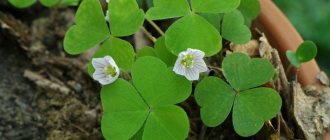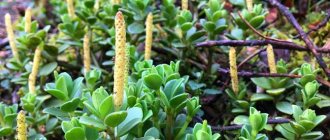Zhiryanka is an insectivorous plant belonging to the perennial genus. However, among the representatives of Pinguicula, where the flower belongs, there are also annuals. Zhiryanka is part of the Bladderweed family, as it prefers to live in water or swampy or any other damp area (river banks, streams, springs, in moss).
Botanical description
The homeland of this carnivorous plant is South America, however, some types of butterwort are often found in Europe and Russian territory. True, not every one of them can grow and bloom normally at home.
The plant has a negative attitude towards any changes , for example, warming or cooling, increasing air pollution.
Therefore, the butterwort is considered an endangered species: its abundant habitats are strictly protected by states, and the flower itself is listed in the Red Book.
Common butterwort is an unusual and useful exotic plant, which is often called oil grass. It amazes with its bright flowers, similar in appearance to violets. With proper care, the flower blooms profusely and for a long time. The flowers are solitary, small in diameter (2-3 cm), arranged in a chaotic manner on a long peduncle. The colors of the flowers are varied - the most common colors are:
- blue;
- pink;
- lilac;
- white;
- violet.
After flowering, the fruits of the bush form capsules. The leaves of the plant are juicy, bright light green in color, fleshy and slightly elongated. In summer they are large, and in winter the leaves become small and acquire a slight fluff.
The plant has glands that secrete a sticky lubricant. It covers the leaves with small droplets that have a sweetish taste. Because of this, the leaves of the bush seem to be fat (hence the name of the plant). It is thanks to the sweet coating that the butterwort destroys insects.
Compared to all insectivorous flowers, only butterwort has true roots.
How to catch insects
The plant's insect catcher is its leaves. Due to the fact that a sweet coating forms on them, insects are attracted. One part of the glands in the butterwort is responsible for the production of plaque, and the other produces enzymes that digest protein compounds. At the bottom of the plant, under the rosette with leaves, there is a false stomach - it contains digestive enzymes.
Compared to other plant predators,
butterwort leaves are not able to curl - in this case, insects stick to the sweet base located on the leaves, from which they cannot escape.
But if a large insect sticks to the bush and tries to get out, the leaves will begin to curl up little by little, thereby actively releasing enzymes that dissolve the victim. After this, the leaf dies, which means that the butterwort needs to renew its foliage every 5-6 days.
Change of leaf at Zhiryanka.
Zhiryanka has a constant change of leaves. New young leaves, clean, beautiful and covered in dew drops, open from the center of the rosette, and the old lower leaves, with insect residues, gradually lose their juiciness, dry out and dissolve in the ground. Old white-transparent leaves can be carefully removed with tweezers, but so as not to tear the stem and leaf from the roots - be careful, if the dead leaf does not stretch out - do not pull, but cut it with scissors. By changing the leaf, the butterwort self-cleans and is ready to absorb insects again and again. Leaf color can range from lush green to pale green to pink to purple.
Varieties and photos
Below are photos, names and descriptions of Zhiryanka varieties suitable for propagation and care at home:
Ordinary
The most common species found in our country. The leaves are oval, some are collected in a rosette, which forms an even circle. The upper part of the leaves has a light green tint. The veins contain glands that form a sticky base and digest insects. The length of the leaves is small - 5 cm, and the width is 3 cm. Drops on the leaves give them an unusual glossy shine.
The flowers of this variety are small, violet-like, and have fine hairs. The diameter of the flowers is 3 cm. Flowering begins in July. The photo below shows the Common Zhiryanka:
Moranskaya
A perennial species that changes foliage in winter and summer. The length of the leaves is on average 13 cm from the root system. They are oval or round, smooth, light green in color, and have many glands.
In winter, rosettes of butterwort consist of leaves, the size of which is no more than 4 cm. Each leaf is covered with fine fluff.
This variety of butterwort blooms with lilac or white flowers. No more than 7 inflorescences bloom on each rosette. The flowers are large - 5 cm in diameter, which makes the bush more interesting. You can see what the Zhiryanka Moranskaya variety looks like in the photo below:
Circular
The most famous type of decorative flower. Its peculiarity is a small rosette with small leaves (3 cm each). As a rule, it is almost flat. The leaves of this variety grow on the stem, arranged in a spiral, which makes it unusual and original. The peculiarity of the round butterfly is that its leaves, intended for hunting insects, begin to grow underground, and not on the stem.
The leaves of this variety of butterwort are silver in color, and the edges have a soft purple tint. The flowers are small, which cannot be said about the peduncle, purple in color, with a slight light rim.
Large-flowered
The plant lives only in damp areas. By touching the leaf, you can see that there are fibers on it. The stem reaches 15 cm in length. It contains up to 30 oblong leaves of the same size. A special feature of the variety is large purple flowers with a white core. Flowering lasts all summer, from late spring to early autumn, after which the butterwort loses its foliage. You can see what Zhiryanka large-flowered looks like in the photo below:
3.Varieties:
3.1.Common butterfly – Pinguicula vulgaris
A herbaceous carnivorous plant that forms a basal rosette of glossy, light green, succulent, entire leaves with a moist, sticky surface. Peduncles are vertical, leafless, slightly curved at the apex, covered with slight pubescence. Each peduncle bears at the top one or several large, attractive flowers with purple, less often pinkish or lilac petals.
3.2.Alpine butterfly – Pinguicula alpina
A perennial miniature herbaceous plant with oblong, light green, moist leaves. Sometimes the leaves or the underside of the leaf blades are colored burgundy. Leafless erect peduncles reach a height of 15 cm, covered with slight pubescence. Each flower stalk can bear up to 8 attractive white flowers with yellow spots on the lower petals.
3.3. Weser butterfly – Pinguicula weser
A delicate herbaceous perennial plant with light green or pinkish, thin leaves collected in a basal rosette. The sticky leaves can reach 5 cm in length. The leafless flower stalks reach a height of 20 cm and bear several attractive lilac flowers at the tops.
You might also be interested in:
Sarracenia
Venus flytrap
Nepenthes
Sundew
Care
Lighting
Zhiryanka at home does not require intense and bright lighting, and direct sunlight is strictly contraindicated for the bush. If it grows in a room, the plant should be placed on a window on the east or west side. It is also permissible to place the flower deep into the room, since it grows and blooms normally in artificial light.
Temperature
During active growth and before flowering, the most favorable temperature is +25-30°C, and in winter +15-18°C. The plant can withstand +35°C, but then it needs to be watered regularly and abundantly, as well as humidify the air.
Watering and humidity
The flower should be watered once 2-3 days during its active growth. In winter, watering only needs to be done once a week, since the plant does not need excess moisture due to the onset of the dormant period and growth cessation. Water for irrigation is taken settled and warm.
When watering, you should not get on the leaves, as this causes rot, which will cause the butterwort to die.
Wiping dust from the leaves or spraying the bush is also prohibited, since this contributes to the rotting of part of the butterwort growing on the surface.
For normal growth, the flower requires high humidity, so there should always be water or moistened expanded clay in the tray with the pot.
Top dressing
Like other predator plants, butterwort does not require feeding. It is permissible to feed the bush only with insects - to do this, you need to place fruits near the flower that will attract them and lure them to the plant. But this feeding option is not mandatory and is optional.
Transfer
The bush needs to be replanted once a year, and an adult plant – once every 2 years. You need to choose a pot that is voluminous, since the butterwort needs space for full flowering. It is recommended to replant in March - this way the flower will have time to adapt to new conditions before flowering begins.
Due to the fact that the roots of the flower are weak, they must not be allowed to rot, otherwise the plant will dry out. To avoid this, you must make holes in the bottom of the pot for water to drain, which will prevent moisture from stagnating.
Transplanting butterwort is very simple - you need to take out the plant with a lump of earth and carefully transfer it to another pot. The soil mixture should be poured into it in advance. After planting, the plant is watered with distilled water and placed in a bright room. It is important to provide the flower with high air humidity - otherwise it will die.
Priming
The ideal option for this predator is acidic substrates intended for insectivorous plants.
You can plant butterwort in a composition made from coarse sand, perlite and peat, with the addition of vermiculite. This is how the plant will feel best.
Trimming
When caring for a flower at home, no pruning is required. You just need to remove limp flower stalks and damaged leaves so that the flower does not lose its decorative effect.
Rest period
The predator, like most plants, rests in the autumn-winter period. At this time, you need to reduce the number of waterings, and also ensure coolness to +15°C .
Reproduction
You can get a new bush in several ways:
Seeds
For seeds to germinate, they need to provide greenhouse conditions. To do this, the seeds are placed in a container with moistened sand and peat soil, and then the container is placed in a warm, dark place. The mini greenhouse needs to be opened periodically to ventilate and spray the soil. After a few weeks, sprouts will appear. When the young plants grow up and get stronger, they are planted in pots in a permanent place.
Leaf
This method of propagation is best used in the fall, when the bush, in preparation for winter, appears with new rosettes .
They are divided into 2-3 parts and placed in prepared soil for rooting. To speed it up, you can create greenhouse conditions. After the roots appear and grow, the young plants are planted in a permanent place.
Dividing the root
This is the easiest way to get a new flower, which is best used in spring. An adult plant should be carefully removed from the pot and divided into several parts (this depends on the size of the roots). Each part of the plant needs to be planted in small pots filled with suitable soil. Caring for young bushes is carried out as usual.
All propagation methods are very simple, and which one to use must be decided in specific conditions.
How to care for butterfly at home
Caring for a butterflower flower does not require any special skills. Even a beginner in floriculture can handle it at home. Zhiryanka is not whimsical to high humidity and light. Three hours of sunlight is enough for her. The butterfly does not like direct daylight, but it does not tolerate deep shade. The adaptation period also goes easily for her.
Watering the butterwort should be done through a tray. It is preferable to use distilled water, but rainwater can also be used. Summer watering is carried out every one or two days, in winter it is reduced to once a week. In order not to disturb the sticky coating on the leaves and stems, it is strictly not recommended to spray the plants. This representative of the flora feels most comfortable in high humidity, so it would be correct to install humidifiers.
Transplantation and substrate
When growing butterwort, it is important to choose the right soil. The best substrate is peat and perlite in equal parts. Perlite can be replaced with coarse sand. When replanting, the plant is removed with a lump of earth, and the substrate is carefully removed from the roots. The prepared pot is filled to the brim with soil, a hole the size of the root system is made, the flower is carefully lowered into it, and then watered with distilled water. The transplanted plant can be covered with a cap and placed in a lighted place. A young plant is replanted once a year; an adult plant needs only once every two years. During the flowering period, the butterwort needs more space. You need to start replanting before the arrival of summer, around March, then the plant will have time to get used to and adapt.
Reproduction of butterwort
You can propagate butterwort in three ways:
In the first method, the seeds are placed in a moistened sand-peat mixture, creating a greenhouse effect for them. The seedlings will appear in a few weeks. Before the seeds germinate, the container is placed in the shade; it is necessary to periodically ventilate and spray the soil. Grown and strengthened butterworts are transplanted to a permanent place.
The second method is better to propagate in the fall. At this time, in preparation for winter, new young rosettes appear on the butterwort. They are used for transplantation, divided into two or three parts, the soil is prepared and planted.
Make sure that this form of transplantation takes place before the active growing season.
You can, as with propagation by seeds, use the greenhouse effect. Cuttings with emerging roots are planted in a permanent place.
The third method of reproduction is probably the simplest. Unlike propagation by leaves, this procedure should be carried out in the spring. Carefully remove the adult plant from the pot along with the soil, divide it into several parts (how many parts depends on the size of the root system). We plant each “plot” in small containers filled with a mixture of perlite and sphagnum. After transplanting, we care for young flowers as usual.
All methods of reproduction are quite simple and effective; it’s up to you to decide which one is more suitable.
When growing butterwort in an apartment, remember that it does not tolerate heat; in the summer, provide your beauty with shade. She loves humidity very much. To solve this problem, very often lovers of this species place plants in terrariums or aquariums.
If the butterwort systematically pleases with flowering, it means she is comfortable and happy with her conditions. A cute “predator” growing on the windowsills will decorate the house and get rid of annoying insects.
Diseases and pests
Zhiryanka is an unpretentious plant that is affected by pests and diseases only when grown in unfavorable conditions. The most commonly observed problems are:
- dry and wrinkled leaves - occurs when the air in the room is very dry or with insufficient watering;
- leaves are dry or with spots from burns - occurs when direct rays of the sun hit the leaf plate;
- the plant does not bloom - observed when there is a lack of light or when the flower is in a cramped pot;
- leaf fall in the autumn-winter period - the plant goes into a dormant state, in which it needs to be provided with cool conditions, bright but diffused lighting and moderate watering;
- the plant rots in winter - excessive watering during dormancy.
Among the pests are aphids and spider mites, which settle on a plant that is grown in a room with too dry air.











